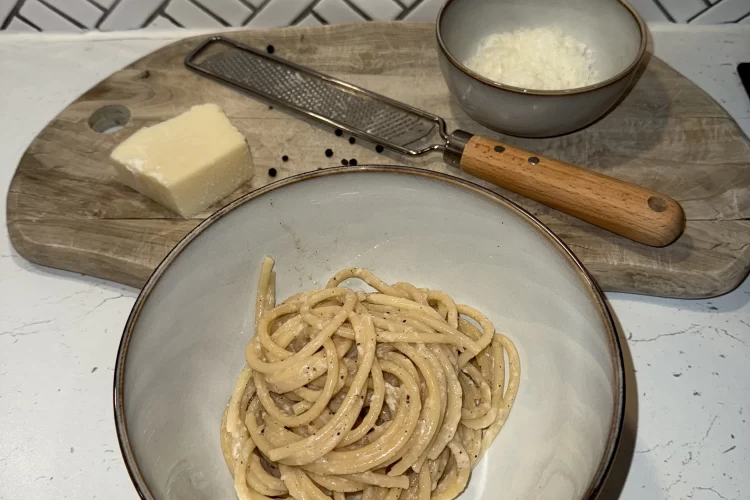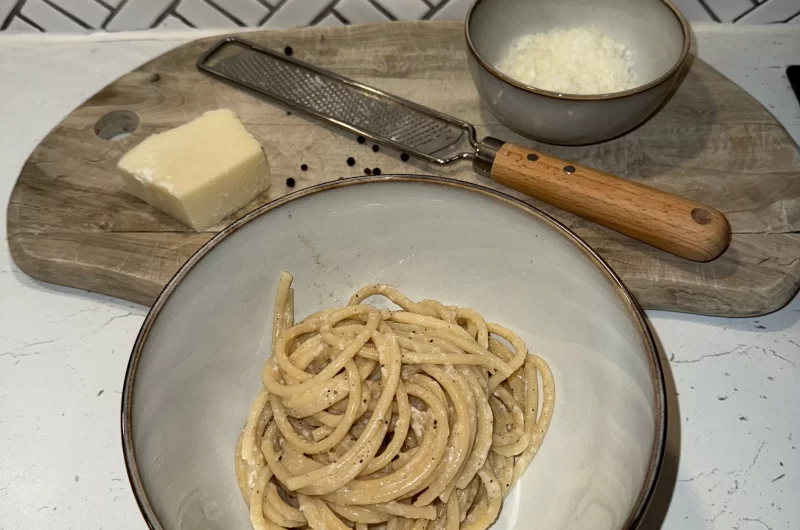Few pasta dishes are as simple yet utterly satisfying as Cacio e Pepe. With just three core ingredients—pasta, Pecorino Romano cheese, and black pepper—this dish is the definition of less is more. Originating from Rome, Cacio e Pepe has stood the test of time, proving that perfect technique is just as important as quality ingredients.
However, despite its simplicity, many people struggle to get that silky, emulsified sauce that clings to every strand of pasta without clumping. The secret? Pasta water and emulsification—a technique that creates a luscious, creamy texture without the need for butter or cream.
In this article, I’ll show you exactly how to master Cacio e Pepe, with a fool proof method that guarantees success every time.
The History of Cacio e Pepe
Cacio e Pepe is one of the most iconic dishes of Roman cuisine, beloved for its rustic simplicity. The name translates to “cheese and pepper” (cacio means cheese in Roman dialect, and pepe means pepper).
Originally, shepherds in Lazio relied on long-lasting, non-perishable ingredients while traveling through the hills. They carried dried pasta, aged Pecorino Romano, and black pepper, making Cacio e Pepe the ultimate shepherd’s meal—hearty, quick, and made with readily available ingredients.
Today, it’s served everywhere in Rome, from local trattorias to Michelin-starred restaurants. But you don’t need a trip to Italy to enjoy it—you can make the perfect Cacio e Pepe at home with my fool proof method.
Why Pasta Water is the Key to Success (Emulsification Explained)
One of the biggest mistakes people make when preparing Cacio e Pepe is adding cheese directly to hot pasta—this causes it to clump and turn into a sticky mess.
The secret to a smooth, creamy sauce is emulsification, a process where fat (cheese) and water (pasta water) combine to create a silky, stable sauce.
How Emulsification Works in Cacio e Pepe
- Pasta releases starch into the water as it cooks, creating a slightly thickened liquid.
- When mixed with finely grated Pecorino Romano and black pepper, this starchy pasta water creates an emulsified sauce that coats the pasta evenly.
- The key is controlling heat—if the cheese is exposed to high temperatures too quickly, it will seize and become lumpy instead of creamy.
By following the right technique, you can ensure a perfect emulsion every time, resulting in a luxuriously smooth sauce.
Why Cacio e Pepe is a Perfect Meal
1. Packed with Flavour Without Heavy Ingredients
Unlike cream-based sauces, this dish is rich but not heavy. The combination of cheese and pepper provides an umami punch, while the emulsified sauce ensures every bite is coated perfectly.
2. Fast and Easy to Make
With just three ingredients, this comes together in under 20 minutes, making it an ideal weeknight dinner or quick meal when you’re short on time.
3. Comforting Yet Elegant
Despite its simplicity, this dish feels indulgent. Whether you’re making it for a casual dinner or serving it at a gathering, it’s always impressive.
FAQs: Common Cacio e Pepe Questions
Can I use Parmesan instead of Pecorino Romano?
While Pecorino Romano is the traditional choice, Parmesan (Parmigiano Reggiano) can work. However, Pecorino is sharper and saltier, giving the dish its authentic Roman flavour.
Why is my cheese clumping?
Your heat may be too high. Always mix the cheese with warm pasta water first, and add it to the pasta over low heat while stirring constantly.
Can I add butter or cream?
Traditionally this contains NO butter or cream. The emulsification process with pasta water creates the creaminess. Adding butter would change the texture, making it more similar to Alfredo.
Final Thoughts: Mastering Cacio e Pepe at Home
This simple dish proves that great food doesn’t have to be complicated. With just three ingredients and the right technique, you can make a restaurant-quality dish in your own kitchen.
The magic of emulsification transforms a simple cheese-and-pepper sauce into a creamy masterpiece, making this one of the most satisfying pasta dishes ever created.
Now that you have this fool proof method, it’s time to try it yourself—because nothing beats a plate of this perfectly made pasta.
Cacio e Pepe
2
servings30
minutes40
minutes300
kcalIngredients
200g (7oz) spaghetti or tonnarelli (traditional Roman pasta)
100g (3.5oz) Pecorino Romano, finely grated
2 teaspoons freshly ground black pepper
Salt (for the pasta water)
Directions
- 1. Boil the Pasta in Lightly Salted Water
Bring a large pot of water to a rolling boil and add a generous pinch of salt. Since Pecorino Romano is quite salty, don’t overdo it—just enough to flavor the pasta.
Cook the pasta until just al dente, about 1 minute less than package instructions. - 2. Toast the Black Pepper
While the pasta cooks, heat a large pan over medium heat. Add the freshly ground black pepper and toast it for about 1 minute until fragrant. This releases its essential oils, enhancing the flavor.
Pro Tip: Use coarsely ground black pepper for the best texture and taste. - 3. Reserve the Starchy Pasta Water
Before draining, scoop out about 1.5 cups (350ml) of pasta water. This is your secret weapon for emulsification. - 4. Start the Emulsification Process
Add half a cup (120ml) of reserved pasta water to the pan with the toasted pepper. Let it simmer for 30 seconds, infusing the water with the spicy aroma of black pepper. - 5. Add the Pasta and Stir Vigorously
Toss the drained pasta directly into the pan, stirring quickly to combine with the pepper-infused pasta water. - 6. Create the Cheese Emulsion (The Most Important Step!)
In a separate bowl, gradually mix the grated Pecorino Romano with a ladle of warm pasta water to create a smooth paste.
Slowly pour this cheese mixture over the pasta, stirring continuously. Add more pasta water as needed until the sauce turns into a silky, creamy coating.
Key Tip: Never add cheese directly to high heat—it will clump. Instead, keep the pan at low to medium heat and stir constantly to allow the cheese to emulsify properly. - 7. Adjust the Sauce and Serve Immediately
If the sauce seems too thick, add a little more pasta water. If it’s too thin, let it cook for an additional minute, tossing constantly.
Plate the pasta and top with extra Pecorino Romano and freshly ground black pepper.



